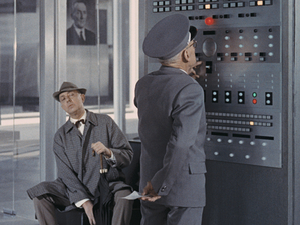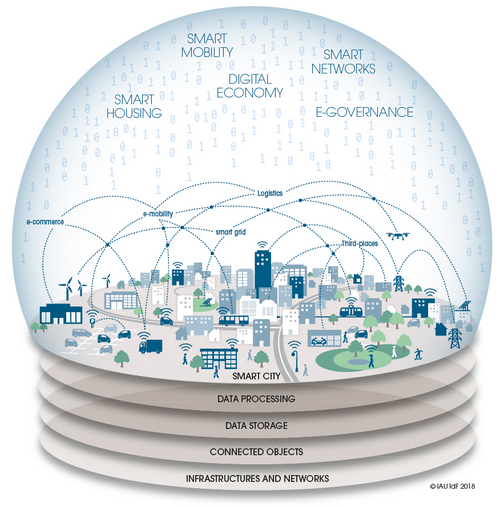Thanks to the embedding of RFID (Radio Frequency Identification) chips, it is possible to track the route of urban waste disposal in order to optimize the recycling circuits. According to the MIT (Massachusetts Institute of Technology), analyzing waste water can be of interest to urban planners (to better understand the inhabitants' way of life), to public health authorities (to prevent epidemics) and to law enforcement (by providing, for example, unexpected information on areas of high drug consumption). These are only two examples, as the range of possible applications seems limitless. For cities, this represents both an extraordinary opportunity and a challenge: although the Smart City as a territory is a site for the intensive production of data, as a public institution is not necessarily a systemic point of convergence and will face competition from new stakeholders. Within a Smart City there are many operators who position themselves as solution-providers, whereas others aggregate data in order to provide information that helps diversify the supply of services. However, in this regard, the borderline between complementariness and competition is particularly fuzzy. The key to success is a city's ability to federate, organize, bring together and simplify things, with a view to delivering an integrated offering to city-users.
A multifaceted city
To preserve and optimize their resources, reduce their organizational costs and foster high-quality urban life, Smart Cities develop shared collective intelligence. The inhabitants are at the heart of this revolution, which blends innovation, environment protection and governance. This presentation focuses specifically on this shared concept, which seems to hold out infinite prospects for use.
In recent years, in the world of urban planning, much has been written about the Smart City concept, a source of much controversy. Today, the emerging consensus of opinion seems to be that there is no single definition of it: in a way, it is also tempting to say that there are almost as many models as there are towns and cities. As indicated by Carlo Ratti, the architect, another finding is that no link has been established between the Smart City concept and architecture, i.e. it is unlikely that we will witness the birth of an architectural model that would apply to almost all towns and cities. The concept is applicable to both new towns in South Korea and the ancient towns and cities of Europe. For some people, it is based, above all, on interaction with citizen residents, whereas for others it is a technological solution to the problem of managing oversized metropolitan areas. Yet, in spite of these differences of opinion, the concept relies on converging objectives and component parts. Among these, as emphasized by Antoine Picon in his interview1, what truly characterizes the Smart City is the quest for more effective use of information technologies, in whatever form. This quest may focus on a great variety of topics: mobility, housing, energy, sustainable development, urban administration, services to inhabitants and citizen participation, etc.
Highly intensive use of technology
The second point of convergence of all Smart Cities seems to be their highly intensive use of technology. Indeed, all smart cities feature a set of infrastructures that make up what could be described as a "digital base" made up of dense high-performance telecom networks, be they wired or free-to-air, including optical fibre networks, coaxial cables, ADSL, WI-Fi, bluetooth, mobile telephone networks, etc. These networks are many and their performance levels and technologies are continually changing. Among the other components of this base are sensors of all kinds, fixed or embedded, cameras and connected objects, all of which cover urban areas and take their pulse in real time by monitoring road traffic, air or sound pollution, security and safety, etc. These urban sensors are also continually changing and multiplying. Their flows interconnect and even clash, because their sources are becoming complex and sometimes compete with each other. Today, it is possible to measure urban traffic using the traditional method featuring sensors embedded in the asphalt, or cameras, or so-called connected vehicles, or the smartphones of vehicle drivers or their passengers. In a completely different area, we can measure, for example, flows of tourists using the geo-tracking function on our mobile phones. Sensors are massively spreading across the urban fabric, a trend which is only beginning. The first generation of fixed urban sensors , whose deployment was slow and expensive albeit planned, is now complemented or even rivalled by the new generations. Smartphones with their geo-tracking feature represented the first wave. The imminent arrival of a very large number of connected objects known more specifically as the "Internet of Things" (IoT) will be the second wave. Data are indeed the lifeblood of the Smart City, the third convergence. Whatever its shape and objectives, the Smart City is based on a continuous flow of data. These data may come in many different forms because they are complex, heterogeneous, unstructured and ever more voluminous, which explains why they are now called "big data". The exponential growth in sensor data combined with the increase in computing power is making it easier and easier to measure, analyze, anticipate and, in short, to model the ever more secret pace of the Smart City.
Urban sensors of all kinds are embedded in the urban fabric to take its pulse in real time
The examples of Rennes and Lyon
Digital modelling is an illustration of strategies adopted by Smart Cities to keep their urban service offering under control. The virtual Singapore program is probably one of the most ambitious examples of digital modelling. In France, the cities of Rennes and Lyon are notable examples that show the scale of the task and the need for stakeholders with different strategies to form complex partnerships. Finally, the fourth and last (but not least) key issue: the inhabitants. No matter how effective technology may be, it is not the main driver of urban development, which is the focus on inhabitants. There can be no Smart City without Smart inhabitants. The challenge facing a Smart City is to be collaborative and inclusive. The Smart City reshuffles the cards of participatory democracy. Beyond being a political expression, putting the citizen-user at the heart of the Smart City is also a basic condition for its effectiveness. Indeed, to outperform, for example, in the fields of energy consumption or waste recycling, a Smart City requires that its smart inhabitants should behave as responsible citizens. These few examples do not summarize all the facets and aspects of a Smart City, but they do show its diversity and the complexity of the ongoing changes. As we have seen, there will not be a single type of Smart City, nor is there likely to be a major architectural upheaval. Becoming a Smart City is not so much a matter of reaching a stage of development that features certain characteristics; rather, it is a matter of undertaking a cycle of continuous changes that ceaselessly reinvent themselves.
Daniel Thépin, economist, IAU îdF
This page is linked to the following category :
Economy

